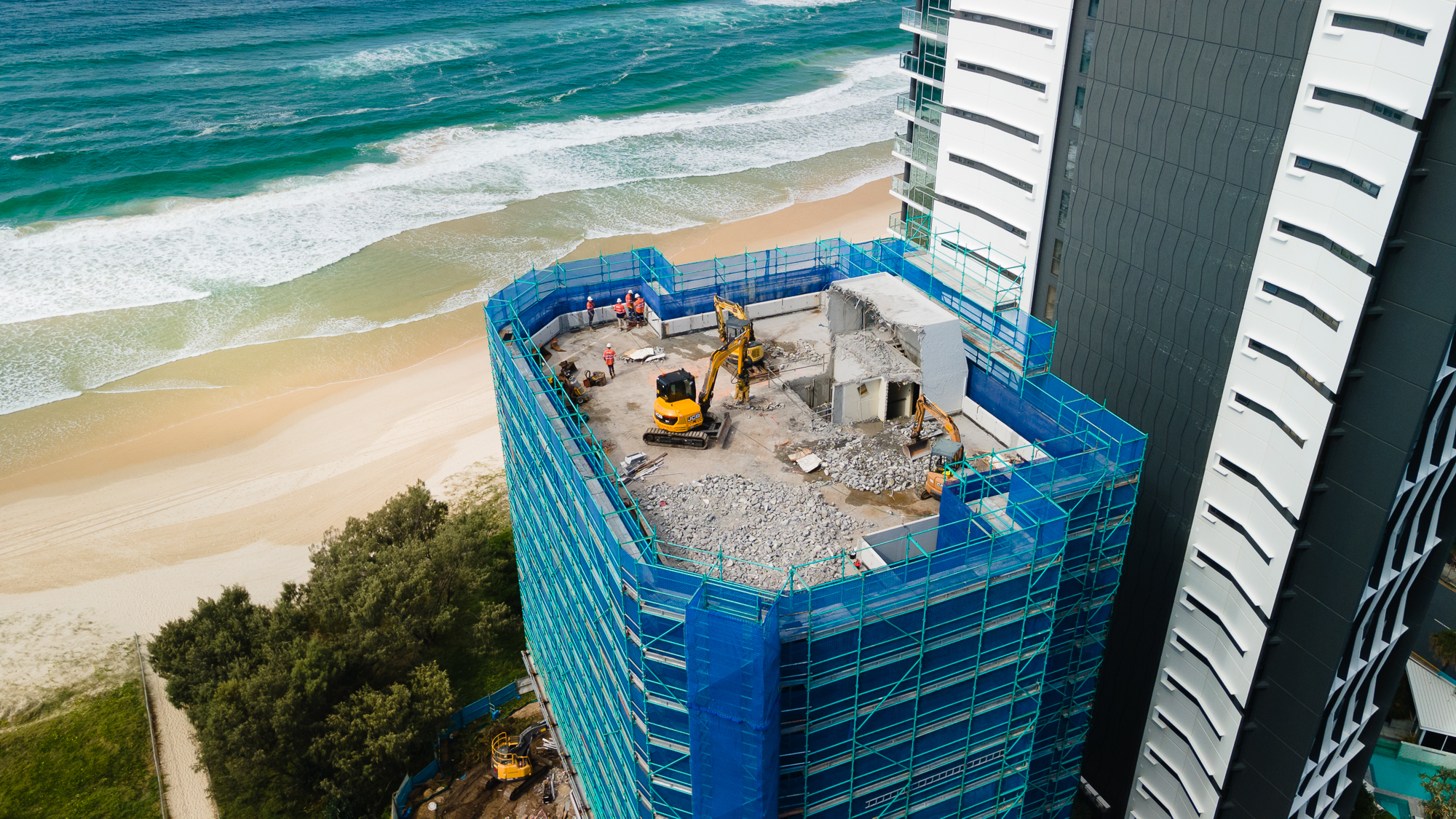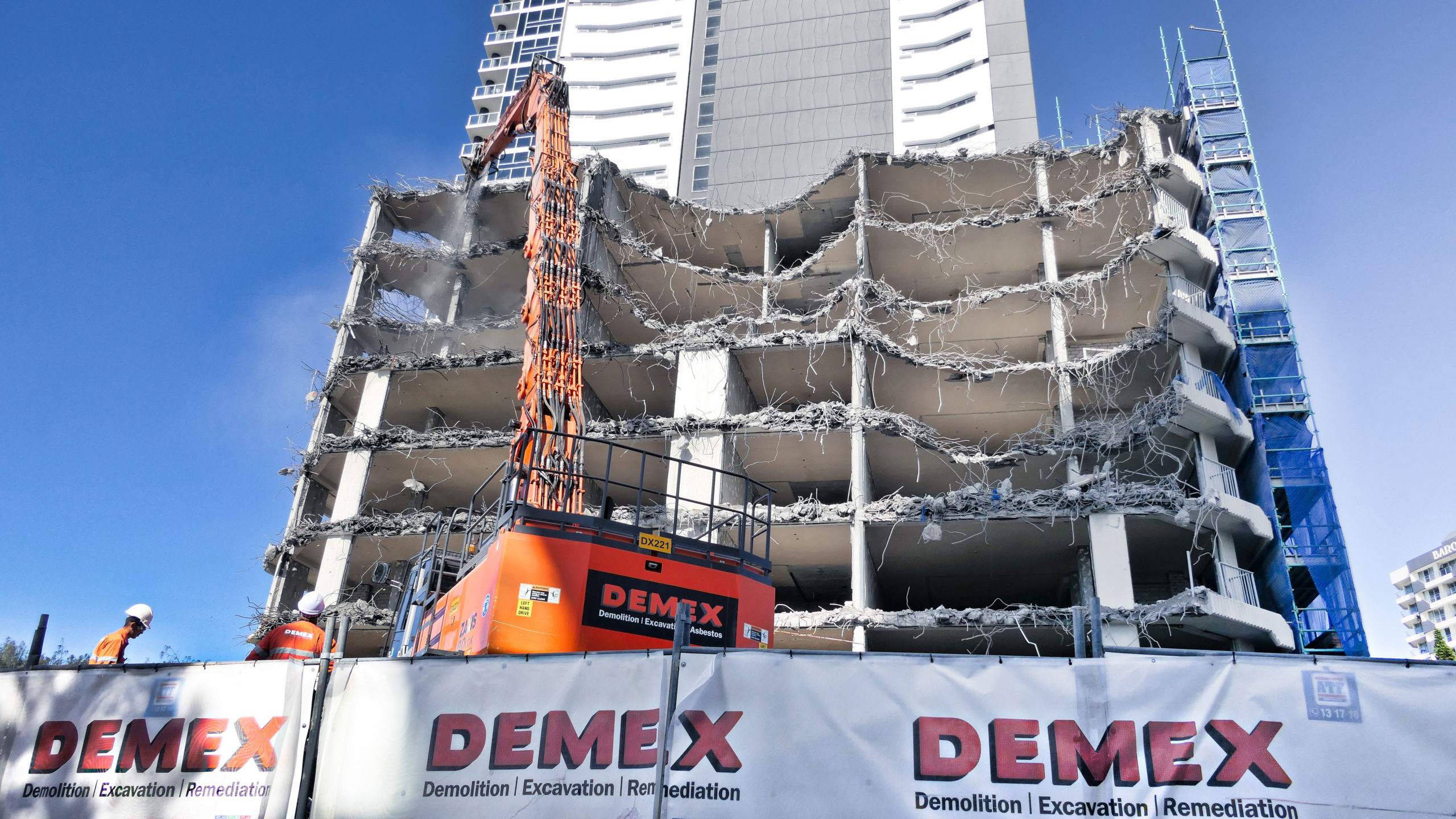Highrise Demolition Contractor

Highrise Demolition Contractor: What every developer should look for
Finding the right highrise demolition contractor for your development project may not be as straightforward as a quick search online.
Demolition techniques and methodologies have advanced significantly in recent decades. There is also growing appreciation of the timing of demolition in any project development pathway, i.e. on the critical path, and that unless the risks and hazards are addressed in full compliance with regulations, the best laid construction plans can be delayed.
All demolition presents risks, however, risks associated with highrise demolition are unique. Safety concerns are ever present. Working at heights can be dangerous. So too is the discovery of unexpected hazmat, like asbestos, lead, silica, chemicals, and heavy metals. Depending on the structure’s age, other factors can be cause for concern. Structural design changes may have been made in a building. Some of these may not even have been approved. These changes could have affected structural strength and stability, which may not be evident until demolition commences. The strength of construction materials may also be unknown, and even the proposed demolition method is likely to carry certain risks with it. Noise and vibration constraints, as well as significant traffic management and mitigating impacts on the local community are all very real considerations because highrise structures are typically found in built up, densely populated city locations.
Together these factors make a sound case for drawing on the experience and technical skills of a specialist highrise demolition contractor. As the industry has matured, so too has the approach to delivering highrise demolition projects safely. Engaging the right highrise demolition contractor provides the opportunity for client and contractor to partner on the project, and thereby realise efficiencies and value that can accelerate a project schedule.
What should you look for in a highrise demolition contractor?
The right equipment
Choice and selection of equipment for project success is key. For its part, top down and interior demolition demands certain equipment that allows a job to be delivered safely and efficiently. Top down demolition is one of a number of demolition methods. It involves the deconstruction of a structure starting at the top and working down to the ground.
Innovation in technology and equipment has led to the introduction of mini excavators for projects applying the top down method. These machines can be lifted onto rooftops, are small enough to fit through standard doorways and manoeuvre in narrow spaces, and have proven to be an ideal solution for projects requiring top down demolition. Combined with a skilled and well trained crew, demolition of each floor can be completed in days.
Adopting this approach in our recent work on the 15 storey Gold Coast icon, Surfers Royale, the team completed each floor safely in an average of just four days. These machines also help mitigate concerns about floor load limits, which prevent the use of larger machinery at heights. An entire building can be completed this way, however depending on the location and street access, high reach excavators specifically designed for demolition works are also an option.
High reach excavators fitted with a range of attachments, like shears, breakers, and grapples, have helped make demolition work safer by reducing the requirement for certain work that was completed manually in the past. Equipment and attachments are constantly being improved, so talk to your demolition contractor about what they use and how it can be applied for a safer, faster project completion.
The right people
Contrary to the commonly held notion that demolition requires more brawn than brain power, there is a requirement for experienced, competent people on the ground, in machinery, and in project supervision and management.
Safety remains the primary concern on every project and a ‘safety first’ approach should be evident in your highrise demolition contractor’s team. In Australia, the industry is heavily regulated and a good sign that safety remains front and centre is in the relationship the contractor has with local safety authority.
For example, WorkSafe has responsibility for ensuring compliance with work health and safety laws in Queensland, and there is a WorkSafe equivalent in every state and territory. On the recent Surfers Royale project, WorkSafe representatives were regular visitors to site and were welcomed by the delivery team who achieved zero safety incidents on the project. Ongoing training and retraining to keep credentials current is a must for all workers, along with detailed site specific planning in advance of a project commencing. This can be backed up by daily toolbox talks on relevant health and safety topics like hazard identification, proper use of personal protective equipment, and hazards of working with equipment.
Robust assessment & detailed planning
Before a single activity has taken place on your project site, robust assessment and detailed planning is required. There is no one size fits all plan, with each one tailored to the site specifically.
Your project team will consider factors like site access (e.g. is the building abutting other structures?), restrictions that affect equipment choices, regulations, and management of resources through recycling or waste disposal. Discovery of unexpected finds make it necessary to amend initial plans.
Note, however, that while changes to the plan may result in variations and impact the schedule, opportunities to accelerate works are identified too. On the same project, the project team obtained approval from the client to bring two high reach excavators to site for the lower eight storeys of the building, a decision which accelerated the overall project schedule by two weeks.
Sustainability commitments
Demolition contractors have long been involved in the recycling of demolition waste, however with increasing community expectations and strict regulations around waste management in place, knowing what goes where from your demolition project has its benefits. Your highrise demolition contractor should be well positioned to provide data on materials that are disposed of and recycled. Statistics like tonnes of ferrous and non-ferrous metals, concrete crushed, asbestos removed, and soil remediated together make a compelling story, particularly where a new development is concerned. It’s not uncommon for a highrise demolition project to achieve recycling of more than 90 percent of materials.
As a developer, it pays to be informed and educated about how to work closely with your demolition contractor. That way opportunities to deliver this aspect of your project safely, even following an accelerated program, can be identified and implemented to lay the foundations for the next step in the project.
DEMEX is a specialist commercial demolition contractor for bridge demolition projects Australia-wide, including in Queensland, New South Wales, the Northern Territory, Western Australia, Victoria and Tasmania. From pedestrian bridges to major infrastructure projects, we understand the need for tailored solutions that adhere to sound demolition and safety principles. Through our experience as a bridge project contractor working in often challenging environments, we have assembled a strong team, from onsite operators to site supervisors and project managers. For information on bridge removal in your state or territory, download our capability statement or contact us directly on info@demex.com.au.





